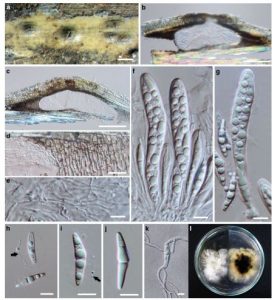Bambusicola pustulata D.Q. Dai & K.D. Hyde, sp. nov. Index Fungorum numbers: IF552022
Etymology: In reference to the ascomata rising as pustules.
Holotype: MFLU 15–1216
Saprobic on dead culm of bamboo, forming dark pustule like spots on the host surface with ascostromata breaking through raised cracks at the centre. Sexual morph: Ascostromata 100–125 μm high, 250–300 μm diam., solitary, scattered or in groups of 2–5, immersed under the host tissue, uni-loculate, subglobose, light brown, coriaceous, ostiolate atthe centre, black at the apex of ostiolar opening, 40–45 μm diam. and 30–35 μm high. Peridium comprising several layers of host and fungal tissues, laterally 30–45 μm thick, composed of brown to hyaline cells of textura angularis, intermingled with host cells, basal part poorly developed; wedge of palisade-like cells at the periphery: 80–105 μm thick, composed of large, thick-walled, dark brown, 4.5– 8×1–3 μm, cells. Hamathecium of dense, long, 0.5–1 μm broad, septate, branched, anastomosing, trabeculate pseudoparaphyses, occurring between and above the asci. Asci 40–60 × 5.5–7 μm (x = 52.6 × 6.3 μm, n = 10), 8-spored, bitunicate, fissitunicate, cylindrical, with a shallow apical chamber and a short furcate pedicel. Ascospores 11.5– 17.5 × 2.5–3.8μm (x = 14.2 × 2.9 μm, n = 20), 2–3-seriate, hyaline, fusiform, 1-septate, occasionally with large upper cell, with narrowly rounded ends, smooth-walled, surrounded by a thick gelatinous sheath 2.5–4.5 μm wide; each cell with 1–2 guttules. Asexual morph: Undetermined.
Culture characters: Ascospores germinating on PDA within 24 h and germ tubes produced at both ends. Colonies slow growing, attaining 35 mm diam. after 40 days at room temperature (25–28 °C), under 12 h light/12 h dark, circular, white on the periphery and yellowish green in center from above, dark yellow to black from below.
Material examined: THAILAND, Phang-Nga Province, Amphoe Mueang Phang-nga, Tambon Tham Nam Phut, forest, 8°26′24″N 98°32′15″E, on dead culms of bamboo, 5 December 2014, Kevin D. Hyde DDQ00289 (MFLU 15– 1216, holotype); Ibid. (KUN HKAS88723, isotype), extype living cultures, MFLUCC 15–0190, MUCL 55887.
Notes: Bambusicola pustulata is similar to B. bambusae in having small, immersed ascostromata, cylindrical asci and slightly broad fusiform, 1-septate, hyaline ascospores (Dai et al. 2012). However, this new taxon differs by having dark ascostromata and smaller ascospores (14.2 × 2.9 μm vs. 17.6 × 3.4 μm), and greener culture (Dai et al. 2012). The branch length of the phylogenetic tree (Fig. 8) also indicates they are different species.
FIG 10 Bambusicola pustulata (MFLU 15–1216, holotype). a Appearance of ascostromata on bamboo host; b, c Vertical section of ascostromata; d Peridium; e Pseudoparaphyses; f, g Asci; h–j Ascospores (h, i Ascospores surrounded by gelatinous sheath); k Germinating ascospore; i Cultures on PDA; Scale bars: a = 500 μm, b, c = 100 μm, d = 10 μm, e–k=5 μm

